Nationality American Name Eugene Cernan Status Retired Role Fighter pilot | Rank Captain, USN Children Teresa Dawn Cernan Time in space 23d 14h 15m | |
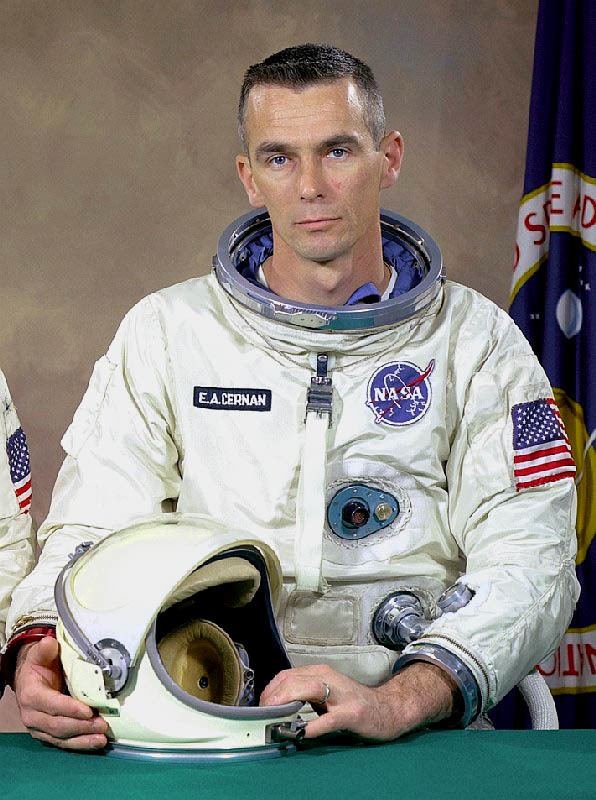 | ||
Born Eugene Andrew Cernan
March 14, 1934
Bellwood, Illinois, U.S. ( 1934-03-14 ) Other occupation Naval aviator, fighter pilot Alma mater Purdue University, B.S. 1956
NPS, M.S. 1963 Space missions Gemini 9A, Apollo 10, Apollo 17 Spouse Jan Nanna Cernan (m. 1987), Barbara Jean Atchley (m. 1961–1981) Movies and TV shows The Last Man on the Moon, When We Left Earth: The NASA Missions, Rocket Science Education Naval Postgraduate School (1963), Purdue University (1956), Proviso East High School Similar People Harrison Schmitt, Thomas P Stafford, John Young, Ronald Evans, Jim Lovell | ||
Eugene Cernan
Eugene Andrew "Gene" Cernan (; March 14, 1934 – January 16, 2017) was an American astronaut, naval aviator, electrical engineer, aeronautical engineer, and fighter pilot. On Apollo 17, Cernan became the eleventh person to walk on the Moon and, as the last man to re-enter the Lunar Module, he is as of 2017 the last man to have walked on its surface.
Contents
- Eugene Cernan
- Early years
- Navy service
- NASA career
- Gemini program
- Apollo program
- Post NASA career
- Personal life
- Death
- Organizations
- Awards and honors
- In popular culture
- References

He traveled into space three times: as Pilot of Gemini 9A in June 1966, as Lunar Module Pilot of Apollo 10 in May 1969, and as Commander of Apollo 17 in December 1972, the final Apollo lunar landing. Cernan was also a backup crew member for the Gemini 12, Apollo 7 and Apollo 14 space missions.
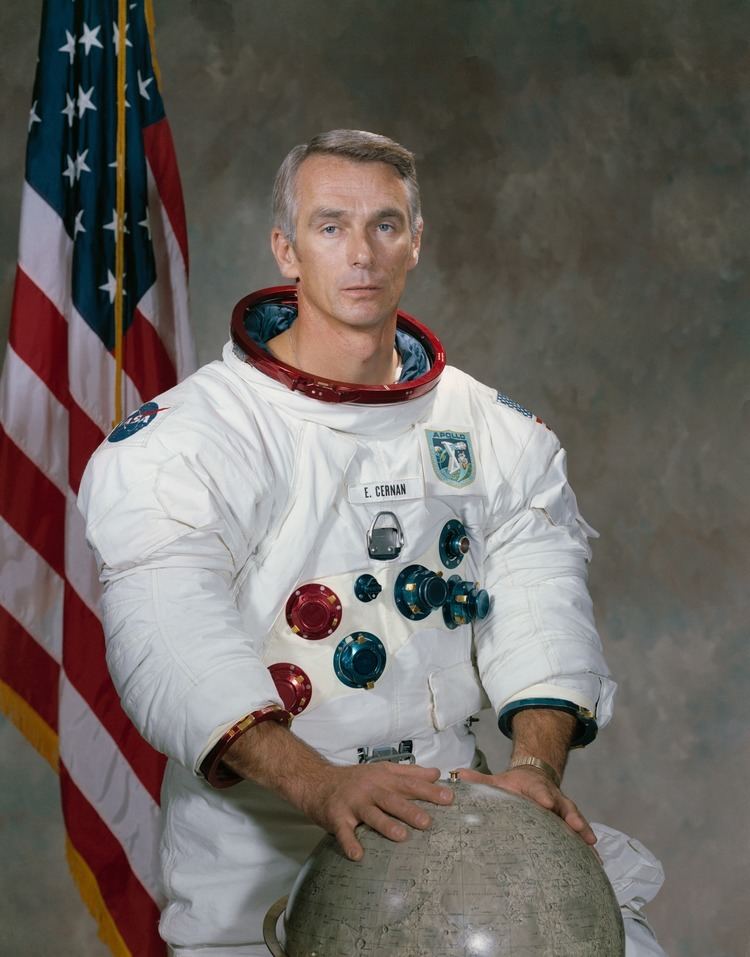
Early years
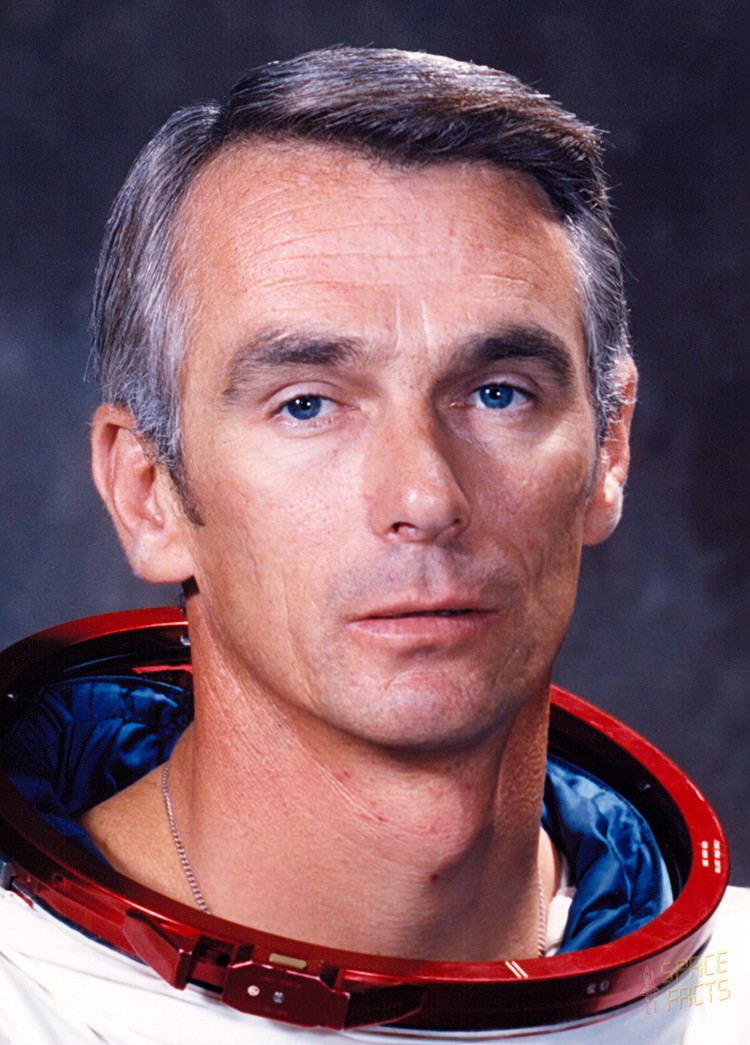
Cernan was born on March 14, 1934, in Chicago, Illinois, the son of Rose (Cihlar) and Andrew Cernan. His father was of Slovak descent and his mother was of Czech ancestry. Cernan grew up in the suburban towns of Bellwood and Maywood. Cernan was a Boy Scout and earned the rank of Second Class. After attending McKinley Elementary School in Bellwood and graduating from Proviso East High School in Maywood, class of 1952, he went on to study at Purdue University, where he became a member of Phi Gamma Delta fraternity. After his sophomore year, he accepted a partial Navy ROTC scholarship, which also required him to serve aboard USS Roanoke between his junior and senior years. He received a Bachelor of Science degree in Electrical Engineering in 1956, where his final GPA was 5.1 out of 6.0.
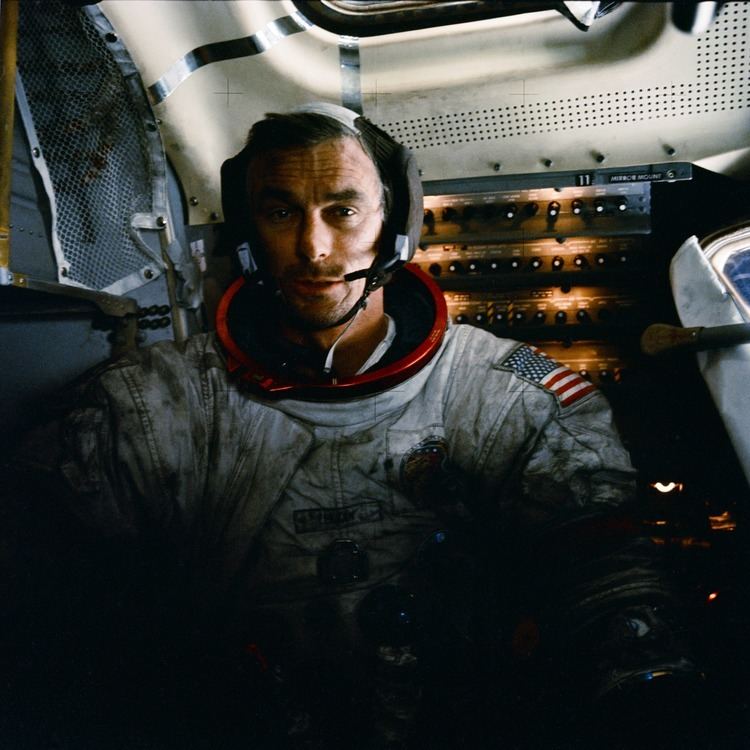
His hobbies included love for horses, sports, hunting, fishing, and flying.
Navy service
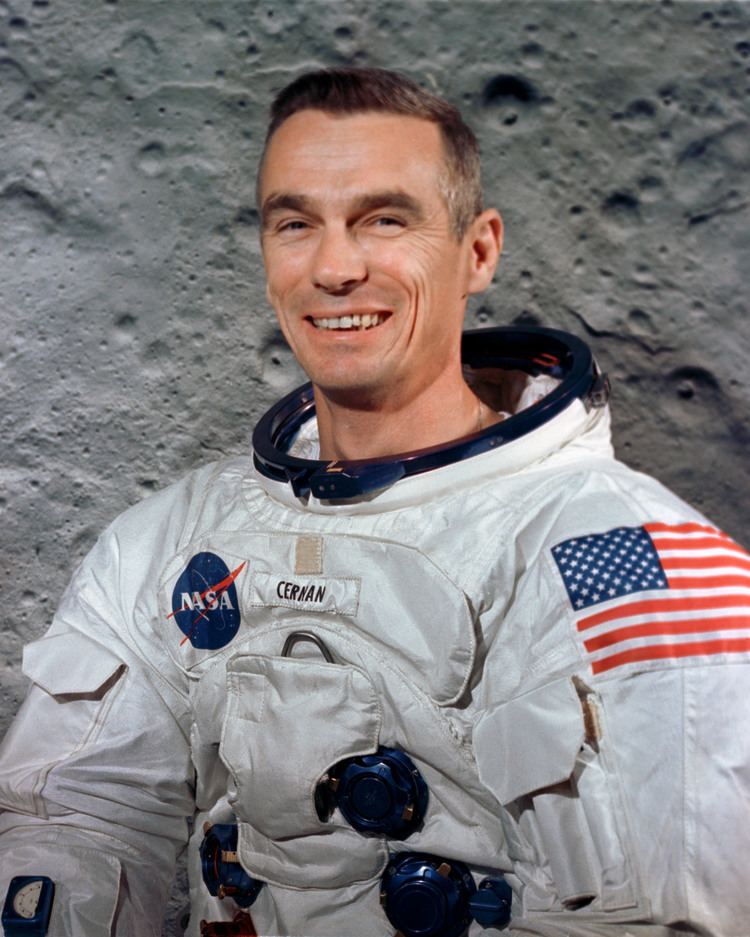
Cernan was commissioned a U.S. Navy Ensign through the Naval Reserve Officers Training Corps at Purdue, and after graduation attended flight training. In 1958, Cernan became a Naval Aviator, flying FJ-4 Fury and A-4 Skyhawk jets in Attack Squadrons 126 and 113. Upon completion of his assignment in Miramar, California, he finished his education in 1963 at the U.S. Naval Postgraduate School with a Master of Science degree in Aeronautical Engineering.
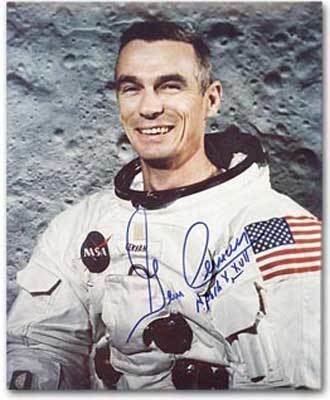
Throughout his career, Cernan logged more than 5,000 hours of flying time, with 4,800 hours in jet aircraft. In addition to his flight hours, Cernan also landed on aircraft carriers 200 times.
NASA career
Cernan was selected among the third group of NASA astronauts in October 1963 by NASA to participate in the Gemini and Apollo programs.
Gemini program
Cernan was originally selected as backup pilot for Gemini 9 with Thomas Stafford. When the prime crew was killed in the crash of NASA T-38A "901" (USAF serial 63-8181) at Lambert Field on February 28, 1966, the backup crew became the prime crew. This was the first time the backup crew had become the flight crew. Gemini 9A encountered a number of problems; the original target vehicle exploded during launch, and the planned docking with a substitute target vehicle was made impossible by a protective shroud failing to separate after launch. However, the crew performed a rendezvous that simulated procedures that would be used in Apollo 10: the first optical rendezvous; and a lunar orbit abort rendezvous. Cernan performed the second American EVA (the third ever), but overexertion due to lack of limb restraints prevented testing of the AMU and forced the early termination of the spacewalk.
Cernan was also a backup Pilot for the Gemini 12 mission.
Apollo program
Cernan turned down the opportunity to walk on the Moon as Lunar Module Pilot of Apollo 16, preferring to risk missing a flight altogether for the opportunity to command his own mission. After the cancellation of Apollo 18, NASA decided to send a scientist, Harrison Schmitt, to the Moon. This decision meant the original Lunar Module (LM) pilot, Joe Engle, never had the opportunity to walk on the Moon. Cernan fought to keep his crew together; however, public pressure from the scientific community cemented Schmitt's position on the crew. Even though Cernan wanted to keep his crew together, he had a positive evaluation of Schmitt's abilities. For example, he believed Schmitt was an outstanding LM pilot and that Engle was merely an adequate one.
Eight months later Cernan was selected as Commander of Apollo 17, the final lunar landing. While on the Moon in December 1972 during Apollo 17, he and his crewmate Schmitt performed three EVAs for a total of about 22 hours of exploration of Taurus–Littrow valley. Their first EVA alone was more than three times the length Neil Armstrong and Buzz Aldrin spent outside the LM on Apollo 11. During this time they covered more than 35 km (22 mi) using the Lunar Rover and spent a great deal of time collecting geologic samples that would shed light on the Moon's early history. Cernan piloted the rover on its final sortie, recording a maximum speed of 11.2 mph (18.0 km/h), giving him the unofficial lunar land speed record.
As Cernan prepared to climb the ladder for the final time, he spoke these words, currently the last spoken by a human standing on the Moon's surface:
Bob, this is Gene, and I'm on the surface; and, as I take man's last step from the surface, back home for some time to come – but we believe not too long into the future – I'd like to just (say) what I believe history will record: that America's challenge of today has forged man's destiny of tomorrow. And, as we leave the Moon at Taurus–Littrow, we leave as we came and, God willing, as we shall return, with peace and hope for all mankind. Godspeed the crew of Apollo 17.
Cernan's being the last person to walk on the Moon means that Purdue University holds the distinction of being the alma mater of both the first person to walk on the Moon (Neil Armstrong), and the most recent. Cernan was one of only three humans to travel to the Moon on two different occasions (the others being Jim Lovell and John Young) and one of only twelve people to walk on the Moon. Apollo 10 holds the world/Moon record for the highest speed attained by any manned vehicle at 39,897 km/h (24,791 mph) during its return from the Moon on May 26, 1969.
Post-NASA career
In 1976, Cernan retired from the Navy with the rank of captain, and from NASA, and went into private business. He became Executive Vice President of Coral Petroleum Inc before starting his own company, The Cernan Corporation, in 1981. From 1987 he was a contributor to ABC News and the weekly "Breakthrough" segment of its Good Morning America morning show for a segment on health, science, and medicine.
In 1999 he published his memoir The Last Man on the Moon with coauthor Donald A. Davis, covering his naval and NASA career. He is featured in the space exploration documentary In the Shadow of the Moon, in which he stated: "Truth needs no defense" and "Nobody can take those footsteps I made on the surface of the moon away from me." Cernan also contributed to the book of the same name.
Cernan and Neil Armstrong testified before U.S. Congress in 2010 in opposition to the cancellation of the Constellation program. It had been initiated during the Bush administration as part of the Vision for Space Exploration with the aim of returning humans to the Moon and eventually Mars, but was deemed underfunded and unsustainable by the Augustine Commission in 2009.
In 2016, Cernan appeared in the documentary The Last Man on the Moon, made by British filmmaker Mark Craig. The film, nine years in the making, is based on Cernan's 1999 memoir of the same title. The film received the Texas Independent Film Award from Houston Film Critics Society and the Movies for Grownups Award from AARP The Magazine.
Personal life
Cernan was married twice. His first wife was Barbara Jean Atchley, a flight attendant for Continental Airlines, whom he married in 1961. They had one daughter, Tracy (born in 1963). In 1980 they separated, divorcing in 1981. They remained friends. His second marriage was to Jan Nanna Cernan, which lasted for nearly 30 years from 1987 until his death. They had two daughters, Kelly and Danielle.
Death
Cernan died in a hospital in Houston on January 16, 2017, at the age of 82. He was laid to rest with full military honors at Texas State Cemetery, the first astronaut to be buried there, during a private service on January 25, 2017.
Organizations
Cernan was a member of several organizations: Fellow, American Astronautical Society; member, Society of Experimental Test Pilots; member, Tau Beta Pi (National Engineering Society), Sigma Xi (National Science Research Society), Phi Gamma Delta (National Social Fraternity), and The Explorers Club.
Awards and honors
In popular culture
On July 2, 1974, Cernan was a roaster of Don Rickles on The Dean Martin Celebrity Roast. At the end of the roast, Rickles (who attended the Apollo 17 launch) paid tribute to Cernan as a "delightful, wonderful, great hero." Cernan was featured in the Discovery Channel's documentary miniseries When We Left Earth: The NASA Missions, providing narrative on his involvement and missions as an astronaut. In the 1998 Primetime Emmy Award-winning HBO miniseries From the Earth to the Moon, he was portrayed by Daniel Hugh Kelly.
Cernan's story of leaving the initials of his daughter, Tracy, written on a rock on the Moon (not something he did in reality – he actually scribbled them in the sand), was prominently mentioned in the 20th episode of the third season of Modern Family. The story, and Cernan's relationship with his daughter in general, was later adapted into "Tracy's Song" by pop-rock band No More Kings. Although he didn't write his daughter's initials on a rock, Cernan himself states in the 2014 Documentary The Last Man on the Moon that he wrote them in the lunar dust as he left the rover to return to the LEM and Earth.
Cernan's voice from the Apollo 17 mission was sampled by Daft Punk for the duo's 2013 album Random Access Memories, in the last track named "Contact". Cernan's last words on the lunar surface, along with Lunar Module Pilot Harrison Schmitt's recollections, were used by the band Public Service Broadcasting for the song Tomorrow, the final track of their 2015 album The Race for Space.
